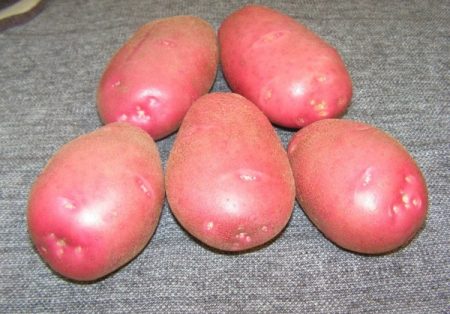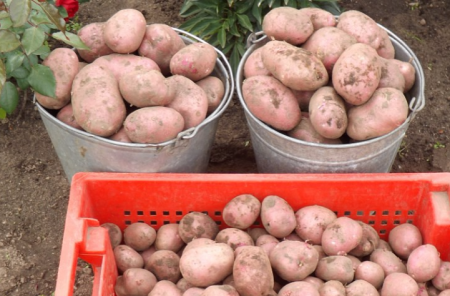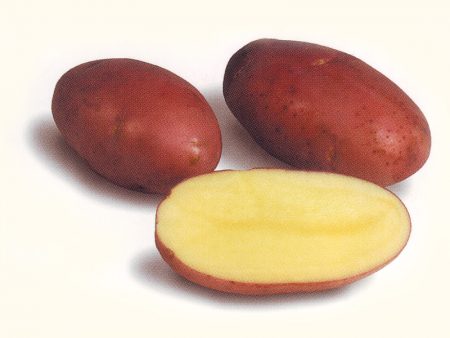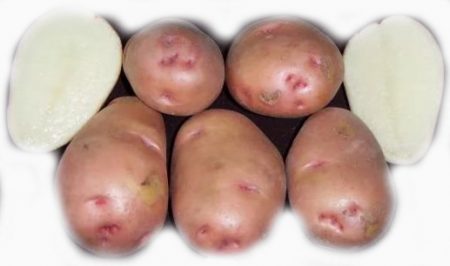
Today, breeders have created more than four thousand varieties of potatoes. Some of them are well known to vegetable growers and enjoy well-deserved success. Among them, there are those that are resistant to a number of common diseases and are not damaged by the Colorado potato beetle. The description of Kamensky potato contains these important characteristics. Numerous reviews by gardeners confirm that this variety is one of the best created by Russian breeders (see photo below).
Kamensky potato is included in the state register of varieties for the Volga-Vyatka and Ural regions. Breeders in the description of Kamensky potato spoke about the unpretentiousness of the plant. Kamensky can be grown in any soil, it tolerates drought well and does not need special care. Despite these conditions, the harvest will always be. The advantage of the variety is resistance to the Colorado potato beetle.
Content
Description
The bush of this variety is erect, of medium height with hard, small, dark green leaves. The edges of the leaves are wavy. Kamensky potato belongs to early ripening varieties, the first crop can be harvested on the 45th day after emergence. Tubers of medium size, elongated, oval. Eyes are small, lie close to the surface. The peel is double, red with pronounced roughness.

The color of the pulp is light yellow. The starch content in the tubers is high, from about 16.5 to 18.9%. The average weight of potatoes is 110-130 gr., The weight of the largest specimens is 180 gr. The productivity of Kamensky potato is stable and high, approximately 50-55 tons per 1 ha.
Characteristics
The variety is productive, drought tolerant, even in bad seasons the quality and quantity of the crop does not suffer. Kamensky adapts well to any soil, grows even in shaded places. Table potatoes are highly rated in palatability. Thanks to the double peel, Kamensky potato withstands transportation over long distances and is resistant to mechanical damage.
Unlike other varieties, Kamensky is resistant to the Colorado potato beetle, as well as to diseases such as cancer, late blight, mosaic and other viral infections. The only disadvantage of this variety is susceptibility to the potato nematode.
Preparation for landing
Like other varieties, Kamensky needs to be germinated. To do this, seed tubers are brought into a warm room and laid in two layers in cordon boxes with slots or simply sprinkle material on the floor. Initially, the temperature in the room should be about +20 degrees, after a week the indicators are reduced to + 10 + 12 degrees. This is necessary so that the shoots do not overgrow.

A week before planting, large potato tubers are cut into two three parts, leaving two well-developed shoots in each half. For preventive purposes, in order to avoid defeat by a nematode and other pests, planting tubers are treated with Nemabakt or Prestige.
Landing
Kamensky potatoes are planted in the first from May 1 to 15. The depth of the holes is about 10 cm, you can add a handful of wood ash or onion husk to them, this will serve as an additional source of nutrition for young plants and scare the wireworm. The potatoes are laid out at a distance of 35 cm from each other, 70 cm are left in rows.
Care
The variety is undemanding to care. After the plants grow a little they spud. The second time the hilling is carried out before laying the buds. Potatoes are watered after the appearance of sprouts and during flowering. Top dressing for this variety is optional, but with very poor soils will not be redundant. During the period of active growth of green mass, potatoes are fed with nitrogen fertilizer (ammonium sulfate, urea), when the plant begins to bloom use phosphorus-potassium mixtures (Superphosphate).

Harvesting and storage
Harvest of this variety is harvested 60 days after planting. The tubers are left outdoors to dry well. Before laying for storage, the tubers are sorted, leaving only healthy and healthy ones. For storage, a clean, dry cellar with a constant temperature of no more than + 2 degrees and a relative humidity of 80% is suitable. Tubers are laid out in wooden boxes or boxes that are placed on pallets. Under good conditions, Kamensky potatoes are preserved up to 97%.
Reviews
Andrey, 50 years old:
“An amazing variety, I was very pleased that I did not have to poison the bugs. The potato tastes delicious, especially fried. In each bush there were 10 large tubers, during the summer they fed once humus during the second hilling. I liked the variety, I recommend it to everyone. ”
Valentina, 46 years old:
“The variety is interested in resistance to the Colorado potato beetle. I must say that this pest bypassed our potato beds side. Harvested enough although the summer was dry, and we did not have the opportunity to water the plantings. We decided to leave the seeds for planting next year. "

Savely, 62 years old:
“A good new variety, the first time I saw a neighbor in the country. That summer there were a lot of beetles, but they didn’t plant potatoes on it, he said that this variety is called Kamensky. In the fall, acquired seeds, in the spring on May holidays, planted on the site after mustard. He dug up the first potatoes in mid-July. The taste is good, there were no beetles during the summer, looked after, like other varieties. In the new season I plan to increase Kamensky’s landing. ”
Julia, 34 years old:
“I was specially looking for a variety of potatoes that defies the Colorado potato beetle and is especially unpretentious. She wrote out seeds via the Internet, as there are no specialized stores in our city. In the spring, a month before planting, she laid the tubers for germination; before planting in the soil, she kept the tubers in a potassium permanganate solution. The plants did not hurt anything, the potato beetle did not touch, which I needed. I dug up the harvest at the end of June, left most of it for a divorce, since Kamensky really liked it, a really unpretentious variety. ”




 Description and description of varieties in Belarus with a photo
Description and description of varieties in Belarus with a photo Do I need to pick flowers from potatoes: why do they do it
Do I need to pick flowers from potatoes: why do they do it When to dig potatoes: timing and availability of new potatoes
When to dig potatoes: timing and availability of new potatoes How to grow a good potato crop: various methods and methods, planting and care
How to grow a good potato crop: various methods and methods, planting and care
Anna
Good day to all. They wrote out the Kamensky variety on the Internet. I really wanted potatoes without a royal bug. There were no beetles until flowering. Really happy. And how he began to bloom so dramatically many bugs appeared. The stems dined in earnest. They did not sprinkle. They collected beetles with their hands. All this is very disappointing !!!